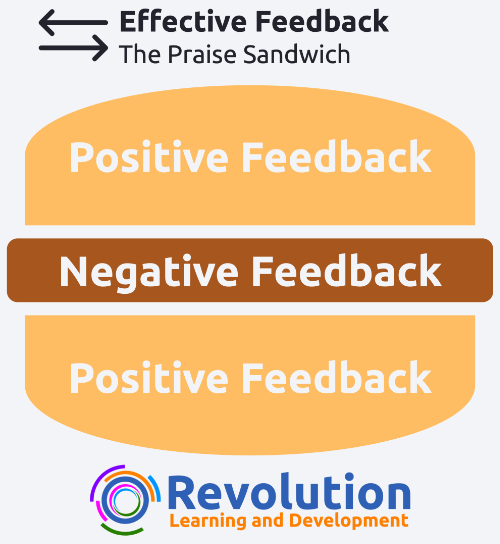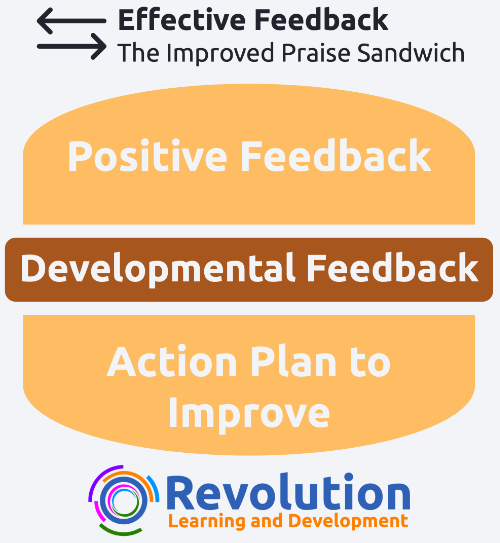What is a Praise Sandwich?
The praise sandwich is a feedback technique that mixes both positive feedback and negative feedback. Its aim is to make a conversation where negative feedback is needed a little easier to handle.
The praise sandwich is also referred to as a feedback sandwich. It’s often used in leadership and management development programmes as a feedback tool to help those that need to provide feedback with a simple structure to follow. Each stage of the praise sandwich should use constructive feedback.
You can learn more about constructive feedback by reading the article What is Constructive Feedback.
The Typical Praise Sandwich
A typical praise sandwich uses the following approach:
- Positive Feedback
- Negative Feedback
- Positive Feedback

The feedback conversation starts with positive feedback. Here we describe something that the person has done well. The feedback is provided should be constructive. The idea of starting with positive feedback is that it puts the person receiving the feedback into a positive state of mind. This should make the negative feedback that follows a little easier to accept.
Next comes the negative feedback. This again should be delivered as constructive feedback.
The final part of the praise sandwich is another round of positive feedback. The aim is to end the discussion on a positive to once again put the person receiving the feedback into a positive state of mind.
Example of a Praise Sandwich
Here is an example of how a typical praise sandwich works:
Positive – “I’m really happy with the way that you speak with customers. Your tone is always friendly and I think your customers enjoy speaking with you”.
Negative – “I do have some concerns with your emails to customers though. Sometimes the tone of your emails can be quite abrupt and this means that customers may see you as being rude”.
Positive – “You are a really important part of the team though. Your colleagues seem to like you and respect the work that you do and I’d like to you keep this up”.
As you can see from the example above, the negative feedback is sandwiched between the 2 pieces of positive feedback.
Why the Praise Sandwich Doesn’t Work
Although the praise sandwich is a very common feedback tool, it does have a massive downside. As 2 of the parts are positive, sometimes the negative part in the middle gets lost and the person leaves the conversation thinking that everything is OK.
The problem is, we need that negative feedback to make a change or drive an improvement in performance. If that negative feedback is lost, that change won’t occur.
This is why the praise sandwich in its current state doesn’t work; however, the principle of the praise sandwich is sound. It is a good structure, but only when used in a slightly different way.
The Improved Praise Sandwich
We can make the praise sandwich much more effective by following the same structure but changing what we deliver at each of the stages.
Firstly, let’s change the language and replace negative feedback with developmental feedback. This sounds much more like we want the feedback to develop the person receiving it and not criticise them.
Secondly, let’s change what is delivered at each stage. Rathe than then previous sections, we change this to:
- Positive feedback
- Developmental feedback
- Action plan to improve

By changing the last part of the conversation into action planning rather than another piece of feedback, we can still end the conversation on a positive by looking at and agreeing on ways that the areas surrounding the developmental feedback can be improved.
This will still have the positive impact as previous, but the person receiving the feedback leaves the conversation with ownership to improve and their focus will be on making the changes.
This gives us a much better outcome too.
An Example of the Improved Praise Sandwich
Here is an example of how a typical improved praise sandwich works:
Positive – “I’m really happy with the way that you speak with customers. Your tone is always friendly and I think your customers enjoy speaking with you”.
Negative – “I do have some concerns with your emails to customers though. Sometimes the tone of your emails can be quite abrupt and this means that customers may see you as being rude”.
Positive – “Let’s take a look at an example and discuss some ways that you can improve this for the future. Which parts do you think are potentially abrupt and how do you think you could change it?”.
Further Learning
You can learn more about delivering effective feedback by attending our Leadership Skills training course. You can see the details of this course on the Leadership Skills Training Course information page.




